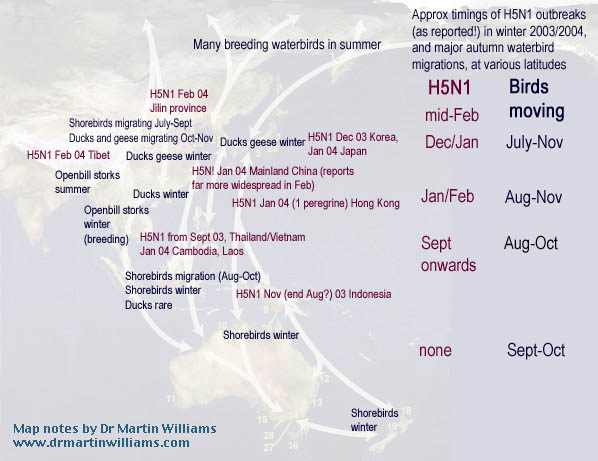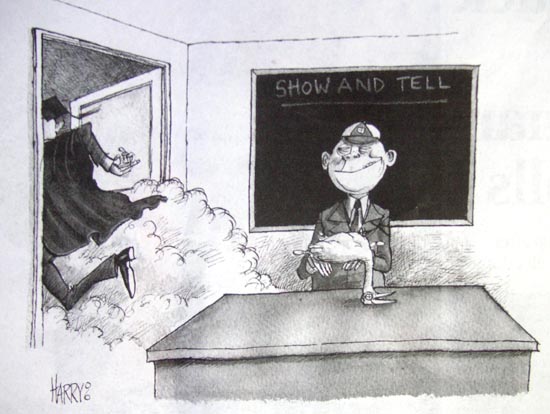


Dear Dr York Chow:
Here's a post I've just made to HKBWS forum:
The witch hunt vs wild birds has eased, but is clearly not over.
Hong Kong was the first place to blame wild birds for spread of H5N1
(poultry flu variant); and not gonna stop blaming wild birds no matter
the evidence.
Here's a bureaucratic, knee-jerk reaction, driven not by science by by
paper pushers who likely barely leave the office (anyone ordering Mai
Po closures ever walked around the reserve at such times, ever noticed
that - as yet - not one case of H5N1 poultry flu at the reserve?).
Dear Dr York Chow:
Here's a post I've just made to HKBWS forum:
The witch hunt vs wild birds has eased, but is clearly not over.
Hong Kong was the first place to blame wild birds for spread of H5N1
(poultry flu variant); and not gonna stop blaming wild birds no matter
the evidence.
Here's a bureaucratic, knee-jerk reaction, driven not by science by by
paper pushers who likely barely leave the office (anyone ordering Mai
Po closures ever walked around the reserve at such times, ever noticed
that - as yet - not one case of H5N1 poultry flu at the reserve?).
I've protested before, long railed against blaming wild birds for being
major vectors of H5N1 poultry flu. But what's the use; logic and
commonsense go out the window when a witch hunt is in progress.
- for far more info on wild birds and H5N1, see my blog/forum at:
http://www.drmartinwilliams.com/ ... nd-migratory-birds/
Yours sincerely,
Dr Martin Williams
Dear Dr. Williams,
Thank you for your email to the Secretary for Food and Health
dated 6
February, 2008 expressing your view on the closure of Mai Po Nature
Reserve
(MPNR) after a dead bird collected around MPNR tested positive against
H5N1
virus.
While we appreciate the inconvenience caused to you by the closure
of the
MNPR, we are of the view that the closure is necessary in order to
protect
public health. We introduced the guideline in 2006 to temporarily
close
the outdoor sections of government owned / managed facilities where a
large
number of wild birds congregates (eg. MPNR, Wetland park) and
walk-in
aviaries in recreational parks for 3 weeks when a dead bird
collected
within 3 km from these facilities as a precautionary measure to
safeguard
public health. It was formulated having regard to the
local
epidemiological picture of Highly Pathogenic Avian Influenza (HPAI)
virus
in wild birds at that time (15 wild birds and 2 stray chickens
found
infected with H5N1 virus) and the fact that HPAI virus can be
transmitted
from wild birds to humans directly or indirectly through
contaminated
materials.
The guideline aims at reducing public contact with possibly
contaminated
materials from wild birds only. Indoor activities in affected
facilities
such as the Education Centre of the MPNR and the indoor section of the
Wetland Park remain accessible to public, subject to the
implementation of
specific biosecurity measures to prevent contaminated materials, which
may
carry HPAI virus, from being brought into such areas.
The Agriculture, Fisheries and Conversation Department (AFCD) had met
with
representatives of the World Wildlife Fund Hong Kong (WWFHK) and the
Hong
Kong Bird Watching Society (HKBWS) in July 2006. It was agreed at the
meeting that WWFHK’s employees working on the management / maintenance/
research work and specialist groups such as the HKBWS engaged in
monitoring
of birds and scientific research activities would be allowed to enter
the
closed area provided that they maintain proper hygiene in the MPNR and
take
appropriate bio-security measures while working in the wild bird
congregation area there.
As there has not been any new case of birds found infected with avian
influenza virus near the Nature Reserve in the past 21 days, the Nature
Reserve has been re-opened to the public on 27 Feb 2008.
Yours sincerely,
Joyce Kok
for Secretary for Food and Health
Hi Joyce:
"HPAI virus can be transmitted from wild birds to humans directly
or indirectly through contaminated
materials."
- any evidence for this.
...
.,..
thought not
Martin
Dear Dr. Williams,
Thank you for your two emails dated 10 March 2008 and thanks again for your
concern on the control of avian influenza measures.
The H5N1 virus we isolated from wild birds in Hong Kong has so far proved
to be highly pathogenic avian influenza virus which can be lethal. As we
could not ignore the possibility that the virus could be transmitted from
wild birds to humans directly or indirectly through contaminated materials,
it would be necessary for the administration to introduce measures to
reduce such risk.
We are sorry for any inconvenience caused to you during the closure of Mai
Po Nature Reserve.
Yours sincerely,
Joyce Kok
Dear Joyce:
Thank you for your email, in which you support my belief there is no scientific basis for closing Mai Po because a dead bird or two with H5N1 has been found nearby.
"we could not ignore the possibility that the virus could be transmitted from wild birds to humans directly or indirectly through contaminated materials"
- this is vague and woolly minded. Not remotely scientific.
As is clear from evidence worldwide, the H5N1 variant of concern is primarily a poultry disease. And whilst the administration has done much to reduce the incidence in local poultry, and associated markets (such as the bird market), we have not lately seen such draconian measures as closure taken recently.
As you should be aware, no wild bird species is known to be capable of surviving, sustaining and spreading H5N1 poultry flu.
It is highly lethal to wild birds, so an infected bird soon sickens, and dies, swiftly ending a potential chain of transmission.
Despite extensive testing, not one apparently healthy wild bird has tested positive for H5N1 poultry flu in Hong Kong.
The dead wild (and "wild" - for some individuals surely or probably from captivity) birds found in Hong Kong that tested positive for h5n1 have been from scattered locations. Despite the bird concentrations at Mai Po, and surveillance there, is it just one case from Mai Po over the years? - in turn, suggesting H5N1 is rare in wild birds, but overwhelmingly outside the reserve.
You might wish to consider just how and where these birds may have contracted the virus - scavenging dead, dumped poultry (smuggled in, so with chance of h5n1), or infected songbirds from captivity?
Especially with birdwatching not involving contact with wild birds, and no case worldwide (that I'm aware of) of a person thought to have contracted h5n1 from a wild bird, there is and was no discernible risk to Mai Po visitors.
Thus, knee-jerk reaction would indeed seem an appropriate description for the Mai Po closures.
Shameful.
Yours sincerely,
Dr Martin Williams
(silence... .... ...)
| Welcome to HKBWS Forum 香港觀鳥會討論區 (http://hkbws.org.hk/BBS/) | Powered by Discuz! 6.0.0 |